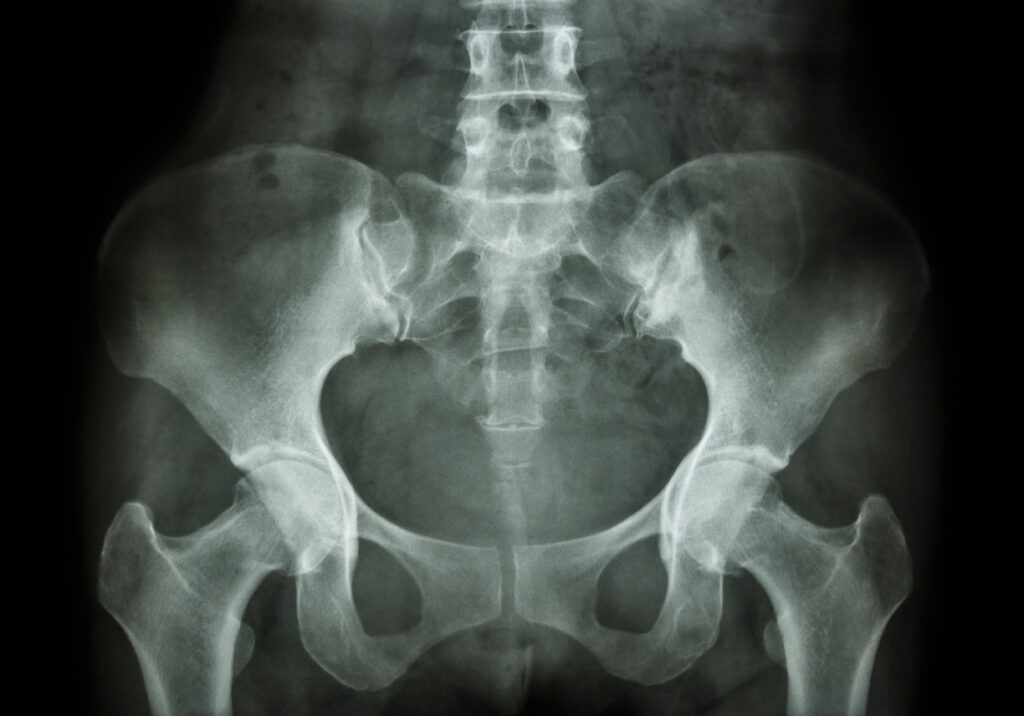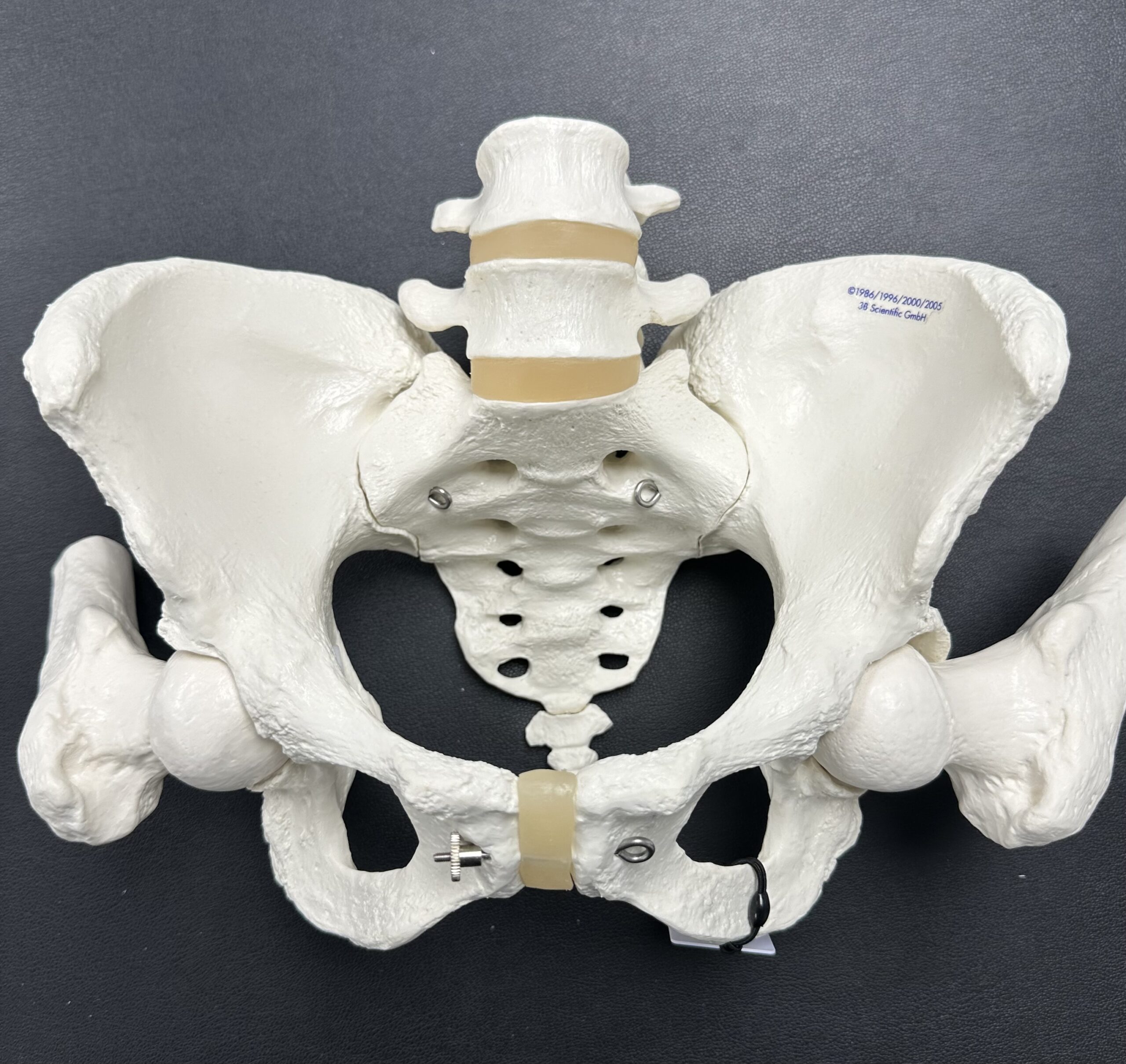Osteitis Pubis is a condition that affects the pubic symphysis, the joint at the front of your body that connects the two halves of your pelvis.
It’s a painful and debilitating condition that can affect anyone but is most common in athletes who play sports that involve twisting and turning, like Basketball, Football and Hockey.
It is also common in pregnancy due to the pelvic forces involved as pregnancy progresses
It can also occur in non-athletes who engage in activities that stress the pelvis like heavy lifting or prolonged sitting
It is frequently caused by inflammation of the pubic symphysis and surrounding structures and can be due to overuse and trauma.
Symptoms include pain in the groin or lower abdomen, difficulty walking or standing and pain during activities that involve the pelvis like running or jumping.
Diagnosis is made through a combination of physical exam, imaging tests and laboratory tests.
While Osteitis Pubis is painful, there are treatments that can help manage symptoms and quality of life.
These may include Rest, Physical Therapy, Medication, Prolotherapy and in some cases Surgery.
With proper treatment and management many people with Osteitis Pubis can get back to their normal activities and live a full and active life.
Causes of Osteitis Pubis
Osteitis Pubis is inflammation in the joint between the left and right pubic bones, the pubic symphysis. This inflammation can be caused by:
Overuse: Repetitive stress on the pubic symphysis from activities like running, jumping or kicking can cause inflammation and pain
Trauma: Direct trauma to the pubic symphysis like a fall or collision can cause inflammation and pain.
Pregnancy and Childbirth: The increased weight and pressure on the pelvic area during pregnancy and childbirth can cause inflammation and pain in the pubic symphysis.
Surgery: Surgery in the pelvic area like prostatectomy or bladder surgery can cause inflammation and pain in the pubic symphysis.
- Infection: In rare cases Osteitis Pubis can be caused by an infection in the pubic symphysis.
Osteitis Pubis Symptoms
Symptoms of osteitis pubis can vary from person to person but some of the most common are:
Pain: The most common symptom of osteitis pubis is pain in the groin and lower abdomen. The pain can be mild or severe and may come and go or be constant. The pain may also radiate to other areas like the hips, thighs or lower back.
Tenderness: People with osteitis pubis may feel tenderness when pressure is applied to the area in front of the pubic bones.
Stiffness: Some people with osteitis pubis may feel stiffness in the groin area which can make it hard to move around or do certain activities.
Difficulty walking: Osteitis pubis can make it painful to walk especially for long distances or on uneven surfaces.
- Difficulty with sports or exercise: People who do sports or other physical activities may find that osteitis pubis makes it hard or impossible to continue. Activities that involve running, jumping or twisting can be very painful.
Note: Symptoms of Osteitis Pubis can be similar to other conditions like hip or groin strains so it’s best to see a doctor for an accurate diagnosis.
Osteitis Pubis
Diagnosing of Osteitis Pubis can often be difficult as it can be mistaken for a hernia, stress fracture or adductor strain.
Physical Examination
Physical examination is part of the diagnosis of OP. The clinician should examine the pelvic region, pubic symphysis, adductor muscles and abdominal wall. The following are some of the physical examination findings that may indicate Osteitis Pubis:
Tenderness over the pubic symphysis
Pain with resisted hip adduction
Pain with passive abduction of the hip
Pain with active straight leg raise
Pain with sit-ups or coughing
A single-leg hop test can reproduce the patient’s symptoms. However, the most specific test for osteitis pubis is a direct-pressure spring test aimed at eliciting tenderness over the pubic symphysis
Imaging Tests
Imaging tests are needed to confirm the diagnosis of Osteitis Pubis. The following are the imaging modalities are often used:
X-ray
Plain radiographs of the pelvis may show bilateral subchondral irregularity, bone erosions and cysts.
X-rays are often not sensitive enough to detect early changes of Osteitis Pubis. When ordering an Xray a specific view should be ordered; the Flamingo view.
Dynamic Instability of the pubic symphysis can be observed on the Flamingo View (obtained by double- and single-legged stance positions bilaterally on a pelvic anterior-posterior radiograph). Greater than 2 mm of subluxation is considered a positive finding for instability of the pubic symphyseal joint.
Ultrasound
In clinic we find Ultrasound to be sensitive in diagnosing Osteitis Pubis. Often bony irregularity is easy to visualise along with any bony erosions or degeneration of the symphyseal joint
MRI
MRI is the most sensitive imaging modality for Osteitis Pubis.
It can show bone marrow oedema and soft tissue inflammation around the pubic symphysis. MRI can also rule out other conditions like stress fracture or hernia.
CT scan
CT scan can also be used to diagnose Osteitis Pubis. It can show bone changes, sclerosis and erosions around the pubic symphysis.
In summary, diagnosis of Osteitis Pubis requires a high degree of suspicion and physical examination. Imaging modalities like MRI and CT scan can help in terms of diagnosis.
Osteitis Pubis Treatment
Physiotherapy
Physiotherapy can help relieve pain and improve mobility in patients with Osteitis Pubis. A physiotherapist can design an exercise program for the patient which may include stretching, strengthening and mobility exercises.
The exercises can involve core strengthening work, adductor strengthening with careful designed rehab protocols depending on the patients normal level of activity
Prolotherapy
Prolotherapy has shown good efficacy for Osteitis Pubis in previous research. The entire groin complex including adductor attachments on the Pubic Symphysis are also treated.
Surgery
Surgery is rarely needed for Osteitis Pubis. But in severe cases where other treatment has failed, surgery may be an option. The most common surgical procedure for Osteitis Pubis is removal of the inflamed tissue and repair of the joint.
In summary, treatment for OP is medication, physiotherapy and in rare cases surgery.
Osteitis Pubis
Preventing Osteitis Pubis is important as it’s a painful condition that causes inflammation around the centre of the pelvis and cause a debilitating effect on daily life and sporting activities
Here are some ways to prevent Osteitis Pubis:
Warm-Up and Cool-Down
One of the most important thing to do to prevent Osteitis Pubis is to warm up properly before any physical activity. This will increase blood flow to the muscles and can help prevent injury. Cooling down after physical activity can also help prevent injury.
Stretching
Stretching before and after physical activity can help prevent Osteitis Pubis. Stretching increases flexibility which can help prevent injury. .
Strengthening Exercises
Strengthening exercises can help prevent Osteitis Pubis by increasing the strength of the muscles in the lower abdominals, adductor muscles, hips and lower back. Strengthening exercises should be done regularly and should be done correctly to prevent injury.
Osteitis Pubis Prognosis
The prognosis for Osteitis Pubis is generally good, most patients will get significant improvement with conservative management. However the time it takes to get better can vary greatly depending on the severity of the condition and the underlying cause.
In cases where Osteitis Pubis is caused by overuse or repetitive trauma, such as in athletes or individuals who engage in strenuous physical activity, rest and modification of activity is key to treatment. In these cases symptoms will resolve in a few weeks to a few months and the patient may return to normal activity level in a few months to a year.
For those with Osteitis Pubis caused by infection or other underlying medical conditions such as rheumatoid arthritis or ankylosing spondylitis, the prognosis may be more unpredictable.
In these cases treatment of the underlying condition is necessary in addition to conservative management of Osteitis Pubis symptoms.
Long term complications of Osteitis Pubis are rare but chronic pain and disability can occur in some cases.
In these cases surgery may be needed to alleviate symptoms and improve function.
Surgery is usually reserved for those who have not responded to conservative management and have persistent symptoms.
FAQs
Can injections treat Osteitis Pubis?
Injections can be used to treat osteitis pubis but effectiveness varies from case to case. Cortisone injections can be used to reduce inflammation and pain in the Pubic Symphysis.
Platelet-rich plasma (PRP) injections and Prolotherapy have also been used to promote healing and reduce pain. Injections for should be used in conjunction with a carefully structured rehab program.
What are the treatment options for Osteitis Pubis?
Treatment for Osteitis Pubis is a combination of rest, physical therapy and Prolotherapy or Cortisone injections. Rest and avoiding activities that aggravate the symptoms can reduce inflammation and promote healing. Physio can improve strength and flexibility in the affected area. In severe cases surgery may be needed.
How long is the Recovery Time for osteitis pubis?
Recovery time for Osteitis Pubis depends on the severity of the condition and individual response to treatment.
In mild cases it can take a few weeks to a few months. In severe cases it can take several months or more. It is important to work with a healthcare provider to develop a treatment plan and monitor progress.
Can Osteitis Pubis be cured?
Osteitis pubis is a chronic condition that can be managed but not cured. Treatment can reduce pain and inflammation and improve function but the condition can flare up again in the future. Continue to monitor symptoms and work with a physical therapist to manage the condition over time.
What causes Osteitis Pubis?
The exact cause of Osteitis Pubis is not known. It is thought to be caused by repetitive stress or trauma to the pubic symphysis which can lead to inflammation and pain.
Osteitis pubis is common in athletes who play sports that involve running, jumping or kicking.
How is Osteitis Pubis diagnosed?
Osteitis pubis is diagnosed through physical examination and imaging tests such as X-rays, Ultrasound, MRI or CT scans. Blood tests may also be done to rule out other conditions (such as inflammatory conditions) that can cause similar symptoms.
What are the symptoms of Osteitis Pubis?
Pain in the pubic area which can be sharp or dull and may radiate to the groin, hips or thighs. Tenderness, swelling and difficulty with walking, running or jumping.






